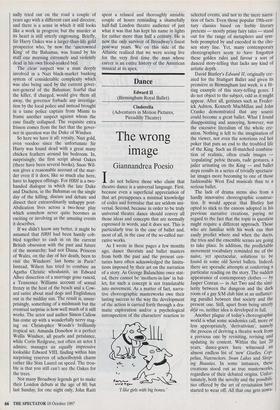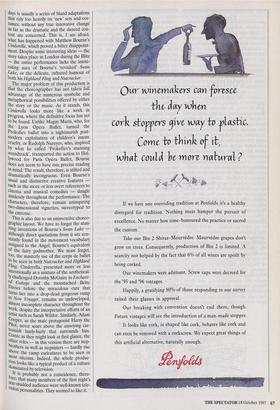Dance
Edward II (Birmingham Royal Ballet) Cinderella (Adventures in Motion Pictures, Piccadilly Theatre)
The wrong image
Giannandrea Poesio
Ido not believe those who claim that theatre dance is a universal language. First, because even a superficial appreciation of that art presupposes a minimal knowledge of codes and formulae that are seldom uni- versal. Second, because in order to be truly universal theatre dance should convey all those ideas and concepts that are normally expressed in words, and it does not. This is particularly true in the case of ballet and, most of all, in the case of the so-called nar- rative works.
As I wrote in these pages a few months ago, dance theorists and ballet masters from both the past and the present cen- turies have often acknowledged the limita- tions imposed by their art on the narration of a story. As George Balanchine once stat- ed, there cannot be 'mothers-in-law' in bal- let, for such a concept is not translatable into movement. As a matter of fact, narra- tive choreographic masterworks owe their lasting success to the way the development of the action is carried forth through a dra- matic exploration and/or a psychological introspection of the characters' reaction to 'I like girls with big bones.' selected events, and not to the mere narra- tion of facts. Even those popular 19th-cen- tury classics based on feeble literary pretexts — mostly prissy fairy tales — stand out for the range of metaphors and sym- bols prompted by and encoded in the cho- sen story line. Yet, many contemporary choreographers seem to have forgotten these golden rules and favour a sort of danced story-telling that lacks any kind of artistic depth.
David Bintley's Edward II, originally cre- ated for the Stuttgart Ballet and given its premiere in Birmingham last week, is a fit- ting example of this story-telling genre. I do not object to the subject, odd as it might appear. After all, geniuses such as Freder- ick Ashton, Kenneth MacMillan and John Cranko demonstrated that any source could become a great ballet. What I found disappointing and annoying, however, was the excessive literalism of the whole cre- ation. Nothing is left to the imagination of the viewer, not even the notorious red hot poker that puts an end to the troubled life of the King. Such an ill-matched combina- tion of realistic, often crude images — 'copulating' pelvic thrusts, rude gestures, a jailer urinating on the King — and ballet steps results in a series of trivially spectacu- lar images more becoming to one of those fashionable West End musicals than to a serious ballet.
The lack of drama stems also from a hardly innovative choreographic construc- tion. It would appear that Bintley has opted to stick to the canons adopted in his previous narrative creations, paying no regard to the fact that the topic in question might require a different approach. Those who are familiar with his work can thus easily predict where and when the duets, the trios and the ensemble scenes are going to take place. In addition, the predictable movement vocabulary reminded me of the naive, yet spectacular, solutions to be found in some old Soviet ballets. Indeed, there are sporadic attempts at conferring a particular reading on the story. The sudden appearance of contemporary clothes — by Jasper Conran — in Act Two and the simi- larity between the dungeon and the dark room of a gay S/M club hint at an unflatter- ing parallel between that society and the present one. Still, apart from being utterly déjà vu, neither idea is developed in full.
Another plague of today's choreographic world is what some academics call, more or less appropriately, `derivativism', namely the process of deriving a theatre work from a previous one by revisiting, revising and updating its content. Within the last 20 years, dance-goers have witnessed an almost endless list of 'new' Giselles, cop- pelias, Nutcrackers, Swan Lakes and Sleep- ing Beauties. In some instances, these creations stood out as true masterworks, regardless of their debated origins. Unfor- tunately, both the novelty and the possibili- ties offered by the art of revisitation have started to wear off. All that one gets nowa- days is usually a series of bland adaptations that rely too heavily on 'new' sets and cos- tumes, without any true innovative change as far as the dramatic and the danced con- tent are concerned. This is, I am afraid, What has happened with Matthew Bourne's Cinderella, which proved a bitter disappoint- ment. Despite some interesting ideas — the story takes place in London during the Blitz — the entire performance lacks the intoxi- cating aura of Bourne's 'revisited' Swan Lake, or the delicate, cultured humour of both his Highland Fling and Nutcracker. The major problem of this production is that the choreographer has not taken full advantage of the numerous symbolic and metaphorical possibilities offered by either the story or the music. As it stands, this Cinderella looks more like a work in Progress, where the definitive focus has yet to be found. Unlike Maguy Mann, who, for the Lyon Opera Ballet, turned the Prokofiev ballet into a nightmarish post- modern exploitation of children's innate cruelty, or Rudolph Nureyev, who, inspired by what he called Prokofiev's stunning soundtrack', transported the action to Hol- lYwood for Paris Opera Ballet, Bourne does not seem to have one precise reading in mind. The result, therefore, is stilted and dramatically incongruous. Even Bourne's usual and distinctive creative features — such as the more or less overt references to cinema and musical comedies — dangle aimlessly throughout the performance. The Characters, therefore, remain uninspiring two-dimensional vignettes, stereotyped to the extreme.
This is also due to an uninventive choreo- graphic layout. We have to forget the stun- ning inventions of Bourne's Swan Lake — although direct quotations from it are con- stantly found in the movement vocabulary assigned to the Angel, Bourne's equivalent °f the fairy godmother. We must forget, too, the masterly use of the corps de ballet to be seen in both Nutcracker and Highland Fling. Cinderella, presented more or less intentionally as a mixture of the aesthetical- ly challenged Dorothy McGuire in Enchant- ed Cottage and the moustached Bette Davies before the miraculous cure that rns her into a drop-dead gorgeous vamp in Now Voyager, remains an undeveloped, almost incomplete character throughout the work, despite the interpretative efforts of an artist such as Sarah Wildor. Similarly, Adam S9oper, as the male protagonist Harry the llot, never soars above the annoying car- °nish hurly-burly that surrounds him. 'onlic as they might look at first glance, the 9ther roles — in this version there are step- brothers as well as stepsisters — hardly rise above the camp caricatures to be seen in 1.1.1ost sitcoms. Indeed, the whole produc- looks like a typical product of a culture uominated by television. f It is probably not a coincidence, there- ore, that many members of the first night's _st.ar-studded audience were well-known tele- vision personalities. They seemed to like it.



























































































 Previous page
Previous page